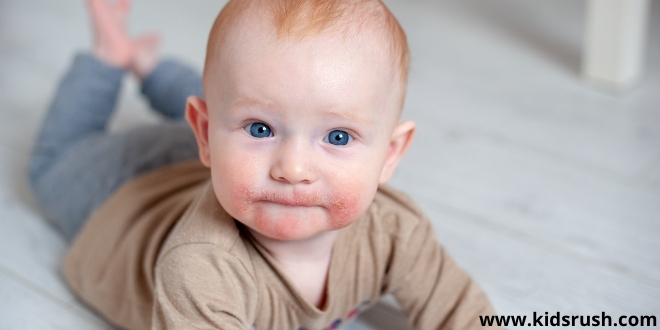Basic care for atopic dermatitis in infants:
Atopic dermatitis in infants is a condition that can cause concern in parents. Fortunately, however, it can be quickly improved with the right treatment.
Atopic dermatitis in infants is one of the most common skin conditions that can occur during the baby’s first months of life. Given that it is a chronic disease, prevention should be the main goal as well as alleviating the symptoms that this condition causes. Early detection of this dermatological condition makes it easier for family members to reduce the symptoms and discomfort it causes.
What is atopic dermatitis in infants?

Atopic dermatitis usually begins between the baby’s third and fifth months of life. At this stage, their skin becomes inflamed with a higher frequency than usual. This usually occurs in the form of outbreaks that last about six weeks, but they can also linger after that.
Atopic dermatitis is an inflammatory skin condition that manifests as dry skin, which is one of its most prominent symptoms. It usually occurs along with intense itching.
The condition usually remains active until the age of two, and then it can either last longer or disappear completely. This is a childhood disease with a certain hereditary component. For that reason, you should consider your family history. [1]
Read Also: How to prevent urine infection in children
When you should consult your pediatrician
Atopic dermatitis has no specific characteristics. It varies from individual to individual. Therefore, it is very difficult to distinguish it from other forms of dermatitis. Only a pediatrician can diagnose atopic dermatitis after examining the symptoms of your child.
So you need to contact your pediatrician if you notice any of the following in your child:
- Non- specific rashes, especially in their facial region and in the diaper area.
- Rash that does not go away on its own after a few days.
- If your child cries often, as it may be due to itching and discomfort in the affected areas.
How to detect atopic dermatitis in infants

Atopic dermatitis can manifest itself in different ways. The most common are the ones we mention below.
Rash usually occurs on the cheeks, forehead, ears, and scalp. They can then spread to the rest of the body, often beginning in the facial region. These rashes are usually itchy eczema and sometimes they can liquefy.
Also, atopic dermatitis may present with an allergy to egg white protein. For this reason, allergy testing must be performed to diagnose an infant.
Read Also: How to cure a dry cough in children
How to prevent atopic dermatitis in children

To treat atopic dermatitis in infants, the family needs help and education:
Natural remedies for atopic dermatitis in infants
- Wash your baby’s clothes with mild detergent and avoid fabric softener.
- Avoid heat, especially hot air. To do this, you must avoid all woolen fabrics, plastics, and certain fibers that make the baby sweaty and thus more sensitive to rashes. Instead, stick to pure cotton.
- Use humidifiers to improve the indoor environment in regions where the humidity is too low.
- Practice proper baby hygiene with short baths or showers, no more than 2-3 times a week. This is because too much water and exposure to bath products can promote the appearance of rashes.
- Doctors recommend that you use a low-pH cleansing cream. Oats are also a good ingredient in cleaning products for children who tend to develop atopic dermatitis.
- Apply moisturizing creams that are specially made for babies. Do this several times a day with a gentle massage so that the cream penetrates the skin properly.
Read Also: What you should know about neonatal jaundice in newborns
Medical care
There are situations where the symptoms of atopic dermatitis in infants may require pharmacological treatment and the supervision of a physician to prevent complications:
- It is important to consult a pediatrician to determine the pattern of current anti-inflammatory treatment during active outbreaks. You must also stop using the emollient lotions you used during the preventative phase.
- Prevent the appearance of skin infections. These usually occur due to scratches that the child gives himself after the itching sets in. You need to make sure to keep these very clean and be careful with hygiene.
If the pediatrician believes that there may be an infection, he or she can prescribe antibiotics that should either be applied to the area in question directly or taken systemically.
Creams with corticosteroids are among the drugs for this condition that pediatricians prescribe the most. You should not be afraid to use them, as long as you do it right. They provide many benefits for infants with dermatitis.
References
